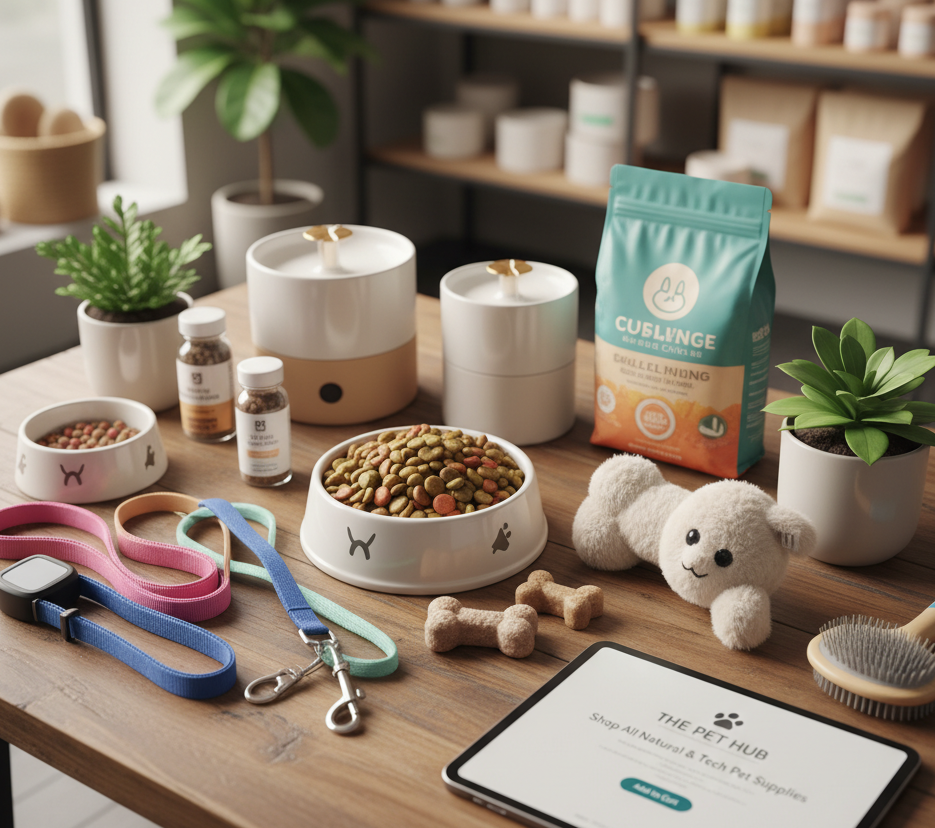The pet industry is experiencing an unprecedented boom, transforming from a niche market into a global phenomenon. At the heart of this growth lies the ever-expanding category of pet supplies. From gourmet food to high-tech gadgets, the sales and transactions surrounding these products are a complex yet lucrative landscape. This article delves into the dynamics of selling pet supplies, exploring key strategies for success, understanding consumer behavior, and optimizing for online visibility in the bustling digital marketplace.
Understanding the Pet Supply Market Landscape
The global pet care market size was valued at billions in recent years and is projected to continue its upward trajectory. Several factors contribute to this growth:
- Humanization of Pets: Pets are increasingly viewed as family members, leading owners to invest more in their health, comfort, and entertainment.
- Rising Pet Ownership: The pandemic, in particular, saw a surge in pet adoption rates, expanding the consumer base.
- Premiumization Trend: There’s a growing demand for high-quality, natural, organic, and specialized pet products, akin to human-grade goods.
- Technological Advancements: Innovations in pet tech, from automatic feeders to GPS trackers, are creating new product categories.
- E-commerce Dominance: Online platforms have made pet supplies more accessible than ever, driving significant sales.
For businesses looking to enter or expand in this market, understanding these underlying trends is crucial for effective sales and transaction strategies.
Key Strategies for Driving Pet Supply Sales
Successfully selling pet supplies requires a multi-faceted approach that caters to diverse customer needs and leverages various sales channels.
- Product Diversification and Niche Targeting:
- Broad Appeal: Offer essential items like staple foods, basic toys, and grooming tools.
- Niche Markets: Identify and cater to specific segments, such as raw food diets, anxiety-reducing products, senior pet care, exotic pet supplies, or sustainable and eco-friendly options. This can attract dedicated customer bases willing to pay a premium.
- Private Labeling: Consider developing your own branded products for better margins and brand loyalty.
- Strategic Pricing:
- Competitive Analysis: Regularly monitor competitor pricing to ensure your products are positioned attractively.
- Value-Based Pricing: Emphasize the benefits and quality of premium products to justify higher price points.
- Bundling and Subscriptions: Offer product bundles (e.g., food + treats + toy) at a slightly reduced price or set up subscription services for recurring purchases like food and litter. This increases average order value and customer lifetime value.
- Exceptional Customer Service:
- Knowledgeable Staff: Whether online or in-store, staff should be well-versed in pet care and product specifics to offer informed recommendations.
- Personalization: Use customer data to recommend relevant products based on past purchases or pet profiles (e.g., “Since your dog loves these treats, you might also like…”).
- Easy Returns/Exchanges: A hassle-free policy builds trust and encourages repeat business.
- Community Building: Create a sense of community around your brand through online forums, social media groups, or in-store events.
- Effective Marketing and Promotion:
- Content Marketing: Create valuable content such as pet care guides, product reviews, training tips, and breed-specific advice. This establishes your brand as an authority and attracts organic traffic.
- Social Media Engagement: Utilize platforms like Instagram, Facebook, and TikTok to showcase products with engaging visuals and videos of pets enjoying them. Run contests, polls, and collaborate with pet influencers.
- Email Marketing: Build an email list to send newsletters, promotions, new product alerts, and abandoned cart reminders.
- SEO Optimization: This is crucial for online visibility (discussed in detail below).
- Local SEO: For brick-and-mortar stores, optimize for “pet supplies near me” searches.
Navigating Online Transactions and E-commerce
The digital realm is where a significant portion of pet supply transactions occur. A robust e-commerce strategy is non-negotiable.
- User-Friendly Website/Online Store:
- Intuitive Navigation: Customers should easily find what they’re looking for, categorize products logically (e.g., by pet type, product type, brand).
- High-Quality Product Images and Descriptions: Visuals are paramount. Detailed descriptions, including ingredients, dimensions, and benefits, are essential.
- Mobile Responsiveness: A large percentage of online shopping happens on mobile devices.
- Fast Loading Speeds: Slow websites lead to high bounce rates.
- Secure Payment Gateways:
- Offer multiple trusted payment options (credit cards, PayPal, Apple Pay, Google Pay).
- Ensure robust security measures (SSL certificates) to protect customer data during transactions.
- Clearly display security badges.
- Efficient Shipping and Logistics:
- Transparent Shipping Costs and Times: Hidden fees or unclear delivery estimates are major conversion killers.
- Variety of Shipping Options: Offer standard, expedited, and potentially local pickup options.
- Reliable Fulfillment: Partner with reputable shipping carriers and consider automated fulfillment solutions.
- Subscription Box Model: Capitalize on the convenience factor by offering curated pet supply boxes delivered regularly.
- Inventory Management:
- Implement systems to track inventory in real-time to avoid overselling and stockouts, which can severely impact customer satisfaction.
- Use forecasting tools to predict demand, especially for popular items.
SEO for Pet Supplies: Getting Found on Google
Appearing high in Google search results is paramount for driving organic traffic and sales. Here’s how to optimize your pet supply website for search engines:
- Keyword Research:
- Target Broad Keywords: “pet supplies,” “dog food,” “cat toys,” “fish tank filters.”
- Long-Tail Keywords: These are more specific and often have higher conversion rates, e.g., “grain-free senior dog food for small breeds,” “interactive cat toys for indoor cats,” “eco-friendly bird cages.”
- Local Keywords: “pet supplies [your city],” “dog grooming [your neighborhood].”
- Competitor Keywords: Analyze what keywords your competitors are ranking for.
- Use tools like Google Keyword Planner, SEMrush, or Ahrefs.
- On-Page SEO:
- Title Tags and Meta Descriptions: Craft compelling, keyword-rich titles and descriptions for every product page and article. These appear in search results.
- Product Descriptions: Integrate keywords naturally within your product descriptions. Focus on benefits and features that align with user search intent.
- Image Optimization: Use descriptive alt text for all images, incorporating keywords. Compress images for faster loading.
- Header Tags (H1, H2, H3): Structure your content with clear headers that include relevant keywords.
- Internal Linking: Link to related products, categories, and blog posts within your site. This helps search engines understand your site structure and passes “link juice.”
- Technical SEO:
- Website Speed: Ensure your site loads quickly on all devices.
- Mobile Friendliness: Google prioritizes mobile-first indexing.
- Schema Markup: Implement schema markup (structured data) for product pages (e.g., price, reviews, availability) to help search engines display rich snippets, enhancing visibility.
- XML Sitemaps and Robots.txt: Ensure your site map is up-to-date and your robots.txt file correctly directs search engine crawlers.
- Content Marketing and Blogging:
- Regular Blog Posts: Consistently publish high-quality, informative, and engaging blog content related to pet care. This is an excellent way to target long-tail keywords and establish authority. Examples: “Top 5 Indestructible Dog Toys,” “Guide to Choosing the Best Litter for Your Cat,” “Understanding Pet Food Ingredients.”
- Answer User Questions: Create content that directly answers common questions pet owners ask.
- Off-Page SEO (Link Building):
- Backlinks: Acquire high-quality backlinks from authoritative pet blogs, news sites, veterinary clinics, or rescue organizations. This signals to Google that your site is trustworthy and relevant.
- Social Signals: While not a direct ranking factor, strong social media engagement can indirectly boost visibility and drive traffic to your site.
The Future of Pet Supply Sales and Transactions
The pet supply industry is dynamic and constantly evolving. Future trends to watch include:
- Further Personalization: AI-driven recommendations and customized subscription boxes based on individual pet needs.
- Sustainability and Ethical Sourcing: Increased demand for environmentally friendly products and ethically sourced ingredients.
- Smart Pet Tech: Integration of smart devices for feeding, monitoring, and entertaining pets.
- Telehealth for Pets: Growth in virtual veterinary consultations influencing product recommendations.
- Augmented Reality (AR): Tools allowing customers to visualize how products might look in their homes or on their pets.
Conclusion
The pet industry supply market offers immense opportunities for businesses willing to adapt and innovate. By focusing on a diverse product offering, strategic pricing, exceptional customer service, and a robust online presence bolstered by comprehensive SEO strategies, businesses can successfully navigate the complexities of sales and transactions. As pets continue to hold a central place in our lives, the demand for quality supplies will only grow, promising a vibrant and profitable future for those who master the art of selling to pet parents.










